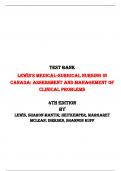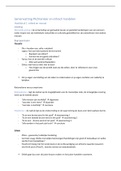-
1. Examen - hdev : human lifespan development 6th edition test bank by spencer a. rathus |all ch...
-
2. Examen - operations and supply chain management 13th edition test bank by f. robert jacobs an...
-
3. Examen - Financial accounting for mbas 8th edition test bank by easton, wild, halsey, mcanall...
-
4. Examen - Introductory chemistry concepts and critical thinking 8th edition test bank by charle...
-
5. Examen - electrocardiography for healthcare professionals 5th edition test bank by kathryn bo...
-
6. Examen - Solution manual for statistics for nursing research a workbook for evidence-based pra...
-
7. Examen - radiation protection in medical radiography 9th edition test bank by mary alice stat...
-
8. Examen - urinalysis and body fluids 7th edition test bank by susan king strasinger, marjorie ...
-
9. Examen - davis advantage for fundamentals of nursing theory concepts and applications 4th edi...
-
10. Examen - nursing leadership, management, and professional practice for the lpn/lvn 7th editio...
-
11. Examen - lpn to rn transitions 5th edition test bank by lora claywell |all chapters, latest-2...
-
12. Examen - Oral pathology for the dental hygienist 7th edition test bank by olga a c ibsen and j...
-
13. Examen - dental radiography principles and techniques, 5th edition test bank by joen iannucci...
-
14. Examen - phillips's manual of i.v. therapeutics: evidence-based practice for infusion therapy...
-
15. Examen - the human body in health and illness 6th edition test bank by herlihy |chapter 1 –...
-
16. Examen - leadership roles and management functions in nursing theory and application 9th edit...
-
17. Examen - heizer operations management 9th edition test bank by jay heizer, barry render |all ...
-
18. Examen - lehninger principles of biochemistry 7th edition test bank by david l. nelson, micha...
-
19. Autre - focus on adult health medical surgical nursing 2nd edition test bank by linda honan ...
-
20. Autre - current medical diagnosis and treatment by maxine papadakis, stephen mcphee, michael...
-
21. Examen - Maternal child nursing care: optimizing outcomes for mothers, children & families 2nd...
-
22. Examen - Microbiology: a systems approach, 6th edition test bank by marjorie kelly cowan, heid...
-
23. Examen - Nursing for wellness in older adults 8th edition test bank by carol a. miller | chapt...
-
24. Examen - Maternity and pediatric nursing 4th edition test bank by susan scott ricci, susan ric...
-
25. Examen - introductory medical-surgical nursing 10th edition test bank by barbara k timby, nan...
-
26. Examen - psychiatric mental health nursing: concepts of care in evidence-based practice 9th e...
-
27. Examen - foundations of nursing 9th edition by kim cooper & kelly gosnell | chapter 1 – 41,...
-
28. Autre - introductory clinical pharmacology 12th edition test bank by susan m ford | chapter ...
-
29. Examen - brown and mulholland’s drug calculations: ratio and proportion problems for clinic...
-
30. Examen - Canadian fundamentals of nursing 6th edition test bank by patricia a. potter, anne g....
-
31. Examen - canadian fundamentals of nursing 6th edition test bank by patricia a. potter, anne g...
-
32. Examen - basic nursing-thinking, doing, and caring, 3rd edition test bank by leslie s. treas,...
-
33. Examen - calculate with confidence 7th edition test bank by deborah gray morris | all chapter...
-
34. Examen - pathophysiology a practical approach 4th edition test bank by lachel story | all cha...
-
35. Examen - primary care the art and science of advanced practice nursing – an interprofessio...
-
36. Examen - Foundations of mental health care 8th edition test bank by morrison-valfre | chapter...
-
37. Autre - lewis's medical-surgical nursing in canada: assessment and management of clinical pr...
-
38. Examen - medical-surgical nursing concepts & practice 5th edition test bank by stromberg | c...
-
39. Examen - pharmacology for canadian health care practice 3rd edition test bank by linda lilley...
-
40. Examen - public health nursing: population-centered health care in the community 10th edition...
-
41. Examen - Safe maternity & pediatric nursing care second edition test bank by luanne linnard-p...
-
42. Autre - Nursing care of older adults: diagnoses, outcomes, and interventions by meridean maas...
-
43. Examen - pharmacology a patient-centered nursing process approach 10th edition test bank by ...
-
44. Examen - Hamric and hanson's advanced practice nursing an integrative approach 6th edition tes...
-
45. Examen - neeb's mental health nursing 5th edition test bank by linda m. gorman, robynn anwar ...
-
46. Examen - seidel's guide to physical examination an interprofessional approach 9th edition tes...
-
47. Examen - critical care nursing diagnosis and management 9th edition test bank by linda d. ur...
-
48. Examen - nursing today: transition and trends 10th edition test bank by joann zerwekh and ash...
-
49. Examen - Davis advantage for pathophysiology introductory concepts and clinical perspectives 2...
-
50. Examen - Bontragers textbook of radiographic positioning and related anatomy 10th edition test...
-
Montrer plus





